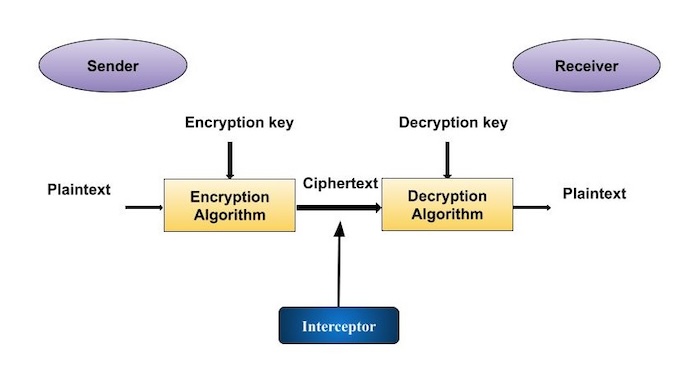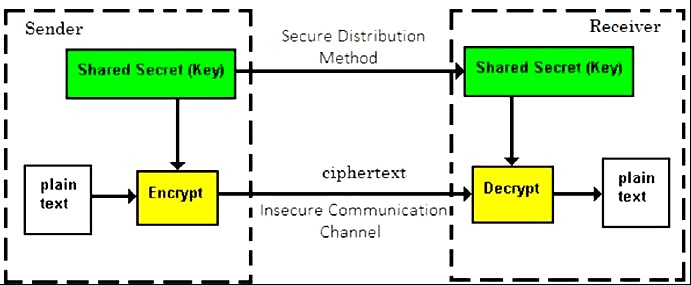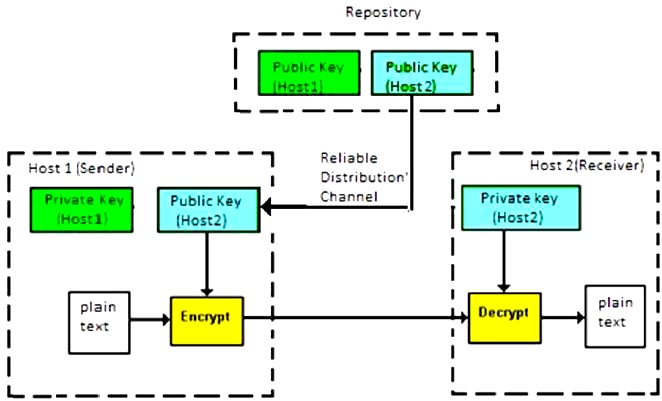
- Cryptography - Home
- Cryptography - Origin
- Cryptography - History
- Cryptography - Principles
- Cryptography - Applications
- Cryptography - Benefits & Drawbacks
- Cryptography - Modern Age
- Cryptography - Traditional Ciphers
- Cryptography - Need for Encryption
- Cryptography - Double Strength Encryption
- Cryptosystems
- Cryptosystems
- Cryptosystems - Components
- Attacks On Cryptosystem
- Cryptosystems - Rainbow table attack
- Cryptosystems - Dictionary attack
- Cryptosystems - Brute force attack
- Cryptosystems - Cryptanalysis Techniques
- Types of Cryptography
- Cryptosystems - Types
- Public Key Encryption
- Modern Symmetric Key Encryption
- Cryptography Hash functions
- Key Management
- Cryptosystems - Key Generation
- Cryptosystems - Key Storage
- Cryptosystems - Key Distribution
- Cryptosystems - Key Revocation
- Block Ciphers
- Cryptosystems - Stream Cipher
- Cryptography - Block Cipher
- Cryptography - Feistel Block Cipher
- Block Cipher Modes of Operation
- Block Cipher Modes of Operation
- Electronic Code Book (ECB) Mode
- Cipher Block Chaining (CBC) Mode
- Cipher Feedback (CFB) Mode
- Output Feedback (OFB) Mode
- Counter (CTR) Mode
- Classic Ciphers
- Cryptography - Reverse Cipher
- Cryptography - Caesar Cipher
- Cryptography - ROT13 Algorithm
- Cryptography - Transposition Cipher
- Cryptography - Encryption Transposition Cipher
- Cryptography - Decryption Transposition Cipher
- Cryptography - Multiplicative Cipher
- Cryptography - Affine Ciphers
- Cryptography - Simple Substitution Cipher
- Cryptography - Encryption of Simple Substitution Cipher
- Cryptography - Decryption of Simple Substitution Cipher
- Cryptography - Vigenere Cipher
- Cryptography - Implementing Vigenere Cipher
- Modern Ciphers
- Base64 Encoding & Decoding
- Cryptography - XOR Encryption
- Substitution techniques
- Cryptography - MonoAlphabetic Cipher
- Cryptography - Hacking Monoalphabetic Cipher
- Cryptography - Polyalphabetic Cipher
- Cryptography - Playfair Cipher
- Cryptography - Hill Cipher
- Polyalphabetic Ciphers
- Cryptography - One-Time Pad Cipher
- Implementation of One Time Pad Cipher
- Cryptography - Transposition Techniques
- Cryptography - Rail Fence Cipher
- Cryptography - Columnar Transposition
- Cryptography - Steganography
- Symmetric Algorithms
- Cryptography - Data Encryption
- Cryptography - Encryption Algorithms
- Cryptography - Data Encryption Standard
- Cryptography - Triple DES
- Cryptography - Double DES
- Advanced Encryption Standard
- Cryptography - AES Structure
- Cryptography - AES Transformation Function
- Cryptography - Substitute Bytes Transformation
- Cryptography - ShiftRows Transformation
- Cryptography - MixColumns Transformation
- Cryptography - AddRoundKey Transformation
- Cryptography - AES Key Expansion Algorithm
- Cryptography - Blowfish Algorithm
- Cryptography - SHA Algorithm
- Cryptography - RC4 Algorithm
- Cryptography - Camellia Encryption Algorithm
- Cryptography - ChaCha20 Encryption Algorithm
- Cryptography - CAST5 Encryption Algorithm
- Cryptography - SEED Encryption Algorithm
- Cryptography - SM4 Encryption Algorithm
- IDEA - International Data Encryption Algorithm
- Public Key (Asymmetric) Cryptography Algorithms
- Cryptography - RSA Algorithm
- Cryptography - RSA Encryption
- Cryptography - RSA Decryption
- Cryptography - Creating RSA Keys
- Cryptography - Hacking RSA Cipher
- Cryptography - ECDSA Algorithm
- Cryptography - DSA Algorithm
- Cryptography - Diffie-Hellman Algorithm
- Data Integrity in Cryptography
- Data Integrity in Cryptography
- Message Authentication
- Cryptography Digital signatures
- Public Key Infrastructure
- Hashing
- MD5 (Message Digest Algorithm 5)
- SHA-1 (Secure Hash Algorithm 1)
- SHA-256 (Secure Hash Algorithm 256-bit)
- SHA-512 (Secure Hash Algorithm 512-bit)
- SHA-3 (Secure Hash Algorithm 3)
- Hashing Passwords
- Bcrypt Hashing Module
- Modern Cryptography
- Quantum Cryptography
- Post-Quantum Cryptography
- Cryptographic Protocols
- Cryptography - SSL/TLS Protocol
- Cryptography - SSH Protocol
- Cryptography - IPsec Protocol
- Cryptography - PGP Protocol
- Image & File Cryptography
- Cryptography - Image
- Cryptography - File
- Steganography - Image
- File Encryption and Decryption
- Cryptography - Encryption of files
- Cryptography - Decryption of files
- Cryptography in IoT
- IoT security challenges, Threats and Attacks
- Cryptographic Techniques for IoT Security
- Communication Protocols for IoT Devices
- Commonly Used Cryptography Techniques
- Custom Building Cryptography Algorithms (Hybrid Cryptography)
- Cloud Cryptography
- Quantum Cryptography
- DNA Cryptography
- One Time Password (OTP) algorithm in Cryptography
- Difference Between
- Cryptography - MD5 vs SHA1
- Cryptography - RSA vs DSA
- Cryptography - RSA vs Diffie-Hellman
- Cryptography vs Cryptology
- Cryptography - Cryptology vs Cryptanalysis
- Cryptography - Classical vs Quantum
- Cryptography vs Steganography
- Cryptography vs Encryption
- Cryptography vs Cyber Security
- Cryptography - Stream Cipher vs Block Cipher
- Cryptography - AES vs DES ciphers
- Cryptography - Symmetric vs Asymmetric
Cryptosystems
A cryptosystem is an implementation of cryptographic techniques and their accompanying infrastructure to provide information security services. A cryptosystem is also referred to as a cipher system.
Let us discuss a simple model of a cryptosystem that provides confidentiality to the information being transmitted. This basic model is depicted in the illustration below −

The illustration shows a sender who wants to transfer some sensitive data to a receiver in such a way that any party intercepting or eavesdropping on the communication channel cannot extract the data.
The objective of this simple cryptosystem is that at the end of the process, only the sender and the receiver will know the plaintext.
Components of a Cryptosystem
The various components of a basic cryptosystem are as follows −
Plaintext. It is the data to be protected during transmission.
Encryption Algorithm. It is a mathematical process that produces a ciphertext for any given plaintext and encryption key. It is a cryptographic algorithm that takes plaintext and an encryption key as input and produces a ciphertext.
Ciphertext. It is the scrambled version of the plaintext produced by the encryption algorithm using a specific the encryption key. The ciphertext is not guarded. It flows on public channel. It can be intercepted or compromised by anyone who has access to the communication channel.
Decryption Algorithm, It is a mathematical process, that produces a unique plaintext for any given ciphertext and decryption key. It is a cryptographic algorithm that takes a ciphertext and a decryption key as input, and outputs a plaintext. The decryption algorithm essentially reverses the encryption algorithm and is thus closely related to it.
Encryption Key. It is a value that is known to the sender. The sender inputs the encryption key into the encryption algorithm along with the plaintext in order to compute the ciphertext.
Decryption Key. It is a value that is known to the receiver. The decryption key is related to the encryption key, but is not always identical to it. The receiver inputs the decryption key into the decryption algorithm along with the ciphertext in order to compute the plaintext.
For a given cryptosystem, a collection of all possible decryption keys is called a key space.
An interceptor (an attacker) is an unauthorized entity who attempts to determine the plaintext. He can see the ciphertext and may know the decryption algorithm. He, however, must never know the decryption key.
Types of Cryptosystems
Fundamentally, there are two types of cryptosystems based on the manner in which encryption-decryption is carried out in the system −
- Symmetric Key Encryption
- Asymmetric Key Encryption
The main difference between these cryptosystems is the relationship between the encryption and the decryption key. Logically, in any cryptosystem, both the keys are closely associated. It is practically impossible to decrypt the ciphertext with the key that is unrelated to the encryption key.
Symmetric Key Encryption
The encryption process where same keys are used for encrypting and decrypting the information is known as Symmetric Key Encryption.
The study of symmetric cryptosystems is referred to as symmetric cryptography. Symmetric cryptosystems are also sometimes referred to as secret key cryptosystems.
A few well-known examples of symmetric key encryption methods are − Digital Encryption Standard (DES), Triple-DES (3DES), IDEA, and BLOWFISH.

Prior to 1970, all cryptosystems employed symmetric key encryption. Even today, its relevance is very high and it is being used extensively in many cryptosystems. It is very unlikely that this encryption will fade away, as it has certain advantages over asymmetric key encryption.
The salient features of cryptosystem based on symmetric key encryption are −
Persons using symmetric key encryption must share a common key prior to exchange of information.
Keys are recommended to be changed regularly to prevent any attack on the system.
A robust mechanism needs to exist to exchange the key between the communicating parties. As keys are required to be changed regularly, this mechanism becomes expensive and cumbersome.
In a group of n people, to enable two-party communication between any two persons, the number of keys required for group is n × (n 1)/2.
Length of Key (number of bits) in this encryption is smaller and hence, process of encryption-decryption is faster than asymmetric key encryption.
Processing power of computer system required to run symmetric algorithm is less.
Challenge of Symmetric Key Cryptosystem
There are two restrictive challenges of employing symmetric key cryptography.
Key establishment − Before any communication, both the sender and the receiver need to agree on a secret symmetric key. It requires a secure key establishment mechanism in place.
Trust Issue − Since the sender and the receiver use the same symmetric key, there is an implicit requirement that the sender and the receiver trust each other. For example, it may happen that the receiver has lost the key to an attacker and the sender is not informed.
These two challenges are highly restraining for modern day communication. Today, people need to exchange information with non-familiar and non-trusted parties. For example, a communication between online seller and customer. These limitations of symmetric key encryption gave rise to asymmetric key encryption schemes.
Asymmetric Key Encryption
The encryption process where different keys are used for encrypting and decrypting the information is known as Asymmetric Key Encryption. Though the keys are different, they are mathematically related and hence, retrieving the plaintext by decrypting ciphertext is feasible. The process is depicted in the following illustration −

Asymmetric Key Encryption was invented in the 20th century to come over the necessity of pre-shared secret key between communicating persons. The salient features of this encryption scheme are as follows −
Every user in this system needs to have a pair of dissimilar keys, private key and public key. These keys are mathematically related − when one key is used for encryption, the other can decrypt the ciphertext back to the original plaintext.
It requires to put the public key in public repository and the private key as a well-guarded secret. Hence, this scheme of encryption is also called Public Key Encryption.
Though public and private keys of the user are related, it is computationally not feasible to find one from another. This is a strength of this scheme.
When Host1 needs to send data to Host2, he obtains the public key of Host2 from repository, encrypts the data, and transmits.
Host2 uses his private key to extract the plaintext.
Length of Keys (number of bits) in this encryption is large and hence, the process of encryption-decryption is slower than symmetric key encryption.
Processing power of computer system required to run asymmetric algorithm is higher.
Symmetric cryptosystems are a natural concept. In contrast, public-key cryptosystems are quite difficult to comprehend.
You may think, how can the encryption key and the decryption key are related, and yet it is impossible to determine the decryption key from the encryption key? The answer lies in the mathematical concepts. It is possible to design a cryptosystem whose keys have this property. The concept of public-key cryptography is relatively new. There are fewer public-key algorithms known than symmetric algorithms.
Challenge of Public Key Cryptosystem
Public-key cryptosystems have one significant challenge − the user needs to trust that the public key that he is using in communications with a person really is the public key of that person and has not been spoofed by a malicious third party.
This is usually accomplished through a Public Key Infrastructure (PKI) consisting a trusted third party. The third party securely manages and attests to the authenticity of public keys. When the third party is requested to provide the public key for any communicating person X, they are trusted to provide the correct public key.
The third party satisfies itself about user identity by the process of attestation, notarization, or some other process − that X is the one and only, or globally unique, X. The most common method of making the verified public keys available is to embed them in a certificate which is digitally signed by the trusted third party.
Relation between Encryption Schemes
A summary of basic key properties of two types of cryptosystems is given below −
| Symmetric Cryptosystems | Public Key Cryptosystems | |
|---|---|---|
| Relation between Keys | Same | Different, but mathematically related |
| Encryption Key | Symmetric | Public |
| Decryption Key | Symmetric | Private |
Due to the advantages and disadvantage of both the systems, symmetric key and public-key cryptosystems are often used together in the practical information security systems.
Kerckhoffs Principle for Cryptosystem
In the 19th century, a Dutch cryptographer A. Kerckhoff furnished the requirements of a good cryptosystem. Kerckhoff stated that a cryptographic system should be secure even if everything about the system, except the key, is public knowledge. The six design principles defined by Kerckhoff for cryptosystem are −
The cryptosystem should be unbreakable practically, if not mathematically.
Falling of the cryptosystem in the hands of an intruder should not lead to any compromise of the system, preventing any inconvenience to the user.
The key should be easily communicable, memorable, and changeable.
The ciphertext should be transmissible by telegraph, an unsecure channel.
The encryption apparatus and documents should be portable and operable by a single person.
Finally, it is necessary that the system be easy to use, requiring neither mental strain nor the knowledge of a long series of rules to observe.
The second rule is currently known as Kerckhoff principle. It is applied in virtually all the contemporary encryption algorithms such as DES, AES, etc. These public algorithms are considered to be thoroughly secure. The security of the encrypted message depends solely on the security of the secret encryption key.
Keeping the algorithms secret may act as a significant barrier to cryptanalysis. However, keeping the algorithms secret is possible only when they are used in a strictly limited circle.
In modern era, cryptography needs to cater to users who are connected to the Internet. In such cases, using a secret algorithm is not feasible, hence Kerckhoff principles became essential guidelines for designing algorithms in modern cryptography.